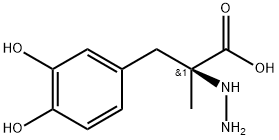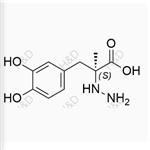Originator
Sinemet,Merck Sharp and
Dohme,Italy,1974
Definition
ChEBI: 3-(3,4-Dihydroxyphenyl)propanoic acid in which the hydrogens alpha- to the carboxyl group are substituted by hydrazinyl and methyl groups (S-configuration). Carbidopa is a dopa decarboxylase inhibitor, so prevents conversi
n of levodopa to dopamine. It has no antiparkinson activity by itself, but is used (commonly as its hydrate) in the management of Parkinson's disease to reduce peripheral adverse effects of levodopa.
Manufacturing Process
To a solution of vanillin in toluene is added nitroethane, butylamine and glacial
acetic acid. The mixture is refluxed and the water of reaction is steadily
azeotropically removed by distillation. After the theoretical amount of water is
distilled out, distillation is continued to remove excess reactants. The last
trace of excess reactants is then removed at room temperature under a
vacuum. The product is then triturated with a hydrocarbon solvent such as
Skellysolve B and is thus obtained in a crystalline state. In general, however,
it is preferred to dissolve the residue directly in toluene for use in the next
step, without isolating the 1-(2-nitropropen-1-yl)-4-hydroxy-3-
methoxybenzene.
A mixture of iron, ferric chloride and water is added to the toluene solution.
The mixture is heated to reflux and concentrated hydrochloric acid is added
dropwise at a rate calculated to keep the mixture refluxing vigorously. After
the hydrochloric acid is all added, the refluxing is continued by the application
of heat for several hours. A siliceous filter aid is then added to the cooled
reaction mixture and the material is removed by filtration. The filter cake is
washed four times, each time with 90 ml of benzene. The organic layer is then
separated from the filtrate. The water layer is acidified to a pH of 2 and
extracted three times with 90 ml portions of benzene.
These extracts are then combined with the organic solvent layer and the
combined organic phase is extracted four times with 100 ml portions of water.
It is then stirred for an hour with 230 ml of 10% sodium bisulfite solution.
The organic solvent phase is then separated, washed seven times with 100 ml
portions of water and dried over magnesium sulfate. Evaporation of the
solvent gives 1-(4-hydroxy-3-methoxyphenyl)-2-propanone in the form of an
oil.
A mixture of 59.5 g of that oily product, 1.85 liters of benzene and 1 kg of
potassium bisulfite in 200 liters of water is stirred at room temperature for
two hours. The precipitated bisulfite addition product of the ketone is isolated
by filtration and washed with isopropanol and then with ether. Five hundred
grams of the adduct is mixed with 119.5 g of potassium cyanide, 292 ml of
85% hydrazine hydrate and 910 ml of water. The mixture is stirred overnight
at room temperature after which the product is isolated by filtration. The
product is washed 3 times with 250 ml portions of water and then 3 times
with 230 ml portions of ether. It is then air dried and vacuum dried at room
temperature.
Fifty cubic centimeters of concentrated hydrochloric acid is saturated with
hydrogen chloride gas at -10°C. To the solution is then added 2.5 g of the
intermediate product, of the formula shown above, slowly with vigorous
stirring. The mixture is allowed to stir overnight while warming at room
temperature gradually. It is then concentrated in vacuo to a syrup. To the
residual syrup is added 100 ml of 48% hydrobromic acid. The reaction vessel
is purged with nitrogen and the reaction mixture is then refluxed for 3 hours
after which it is concentrated in vacuo to a mixture of a syrup and a solid. The residue is taken up in sufficient water to form a clear solution. Activated
charcoal is added and the mixture is heated to boiling and filtered.
The filtrate is concentrated to dryness in vacuo and the residue is taken up in
25 cc of ethanol. The residual ammonium bromide is removed by filtration and
to the filtrate there is added sufficient diethylamine to change the pH to 6.4.
The mixture is warmed to 60°C and then cooled to room temperature. It is
then allowed to stand overnight to effect complete crystallization. It is then
cooled to 0°C and the product is isolated by filtration, washed with methanol
and air dried. The product (α-hydrazino-α-methyl-β-(3,4-dihydroxyphenyl)-
propionic acid) is recrystallized once from water using a proportion of 15 cc
water per gram of product.
Biochem/physiol Actions
Peripheral inhibitor of L-aromatic amino acid decarboxylase. When co-administered with L-DOPA, it prevents extra-CNS conversion to dopamine, thereby increasing CNS concentrations of effective compounds. Selectively cytotoxic to human pulmonary carcinoid and small cell lung carcinoma cells by increasing H2O2 in these cell lines, which are sensitive to reactive oxygen species.




